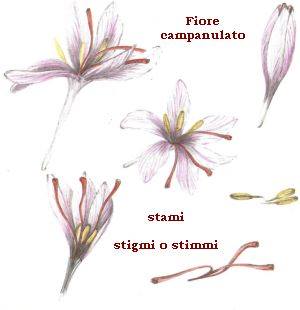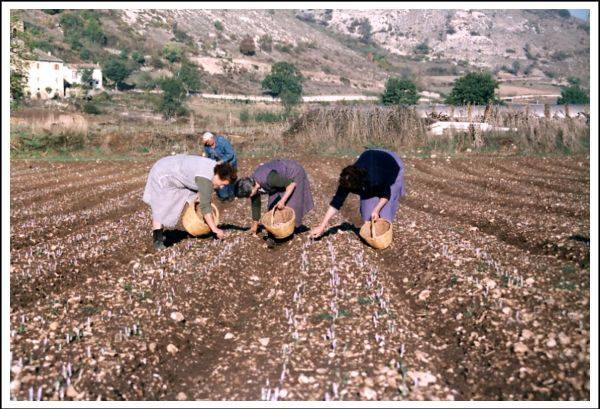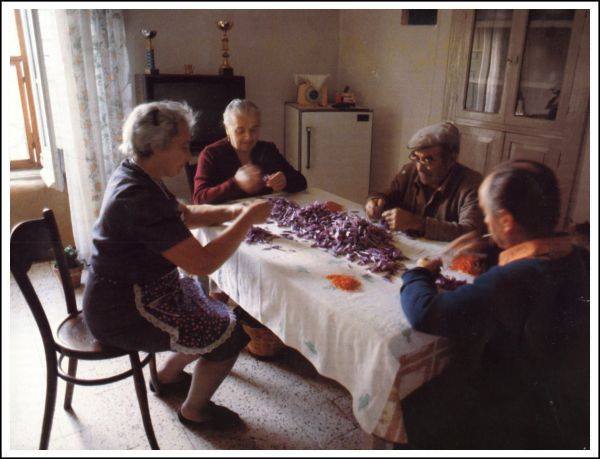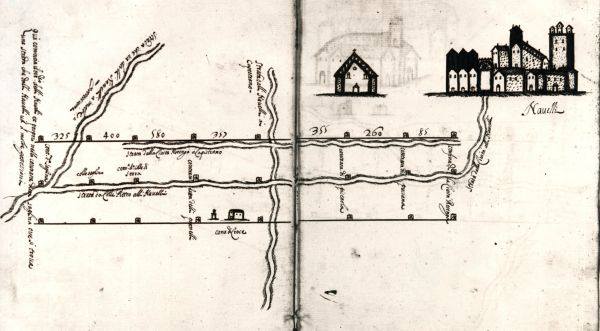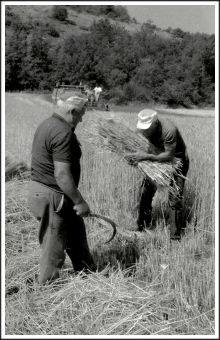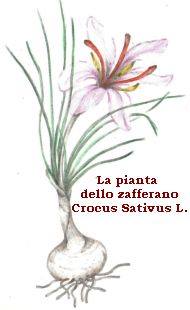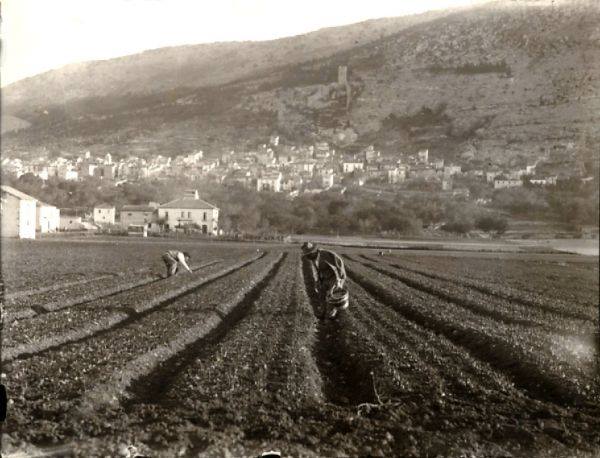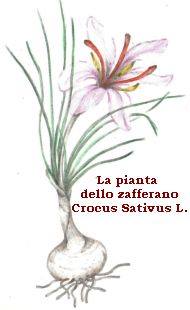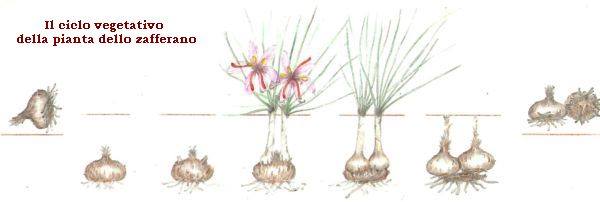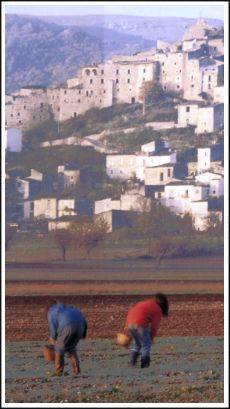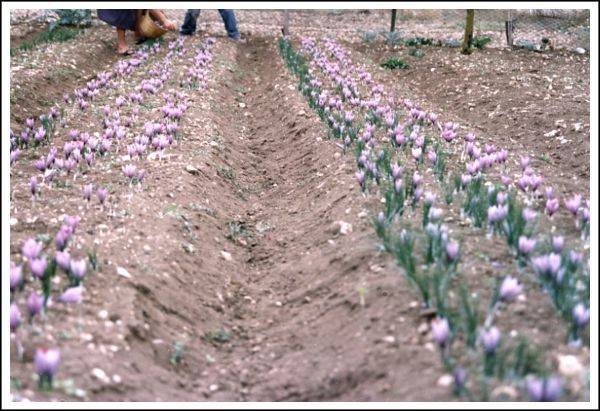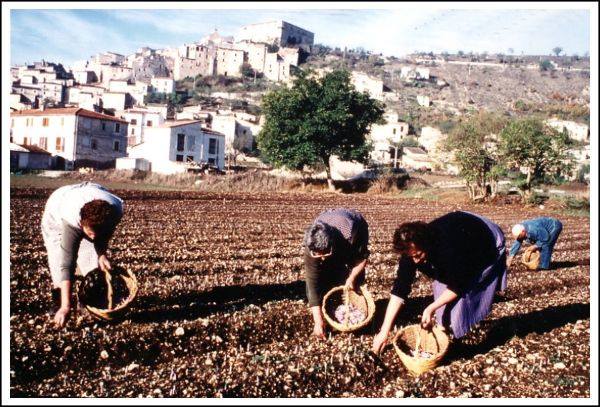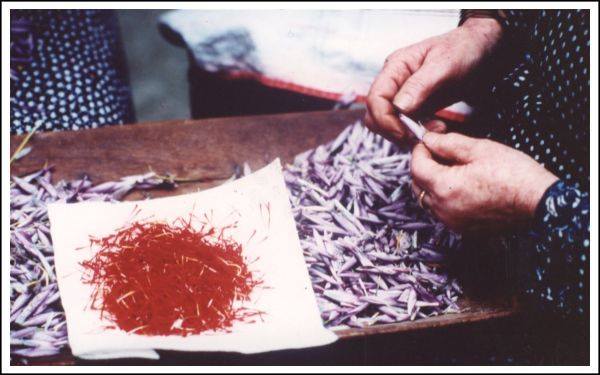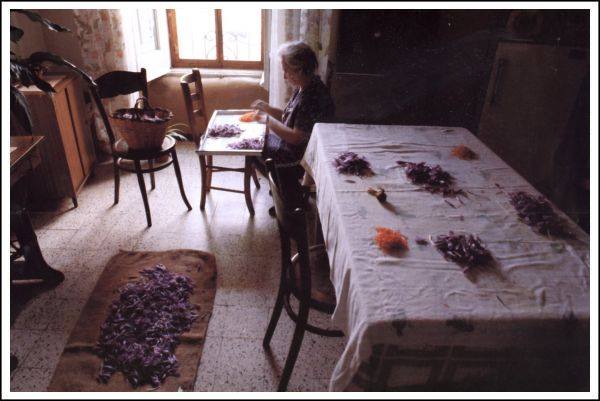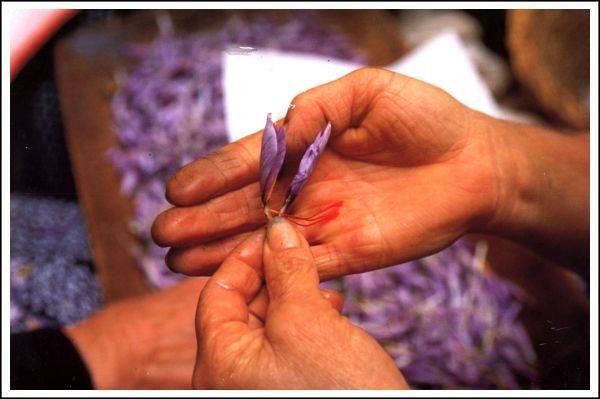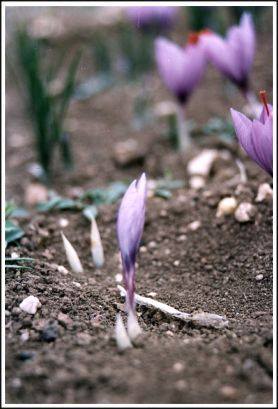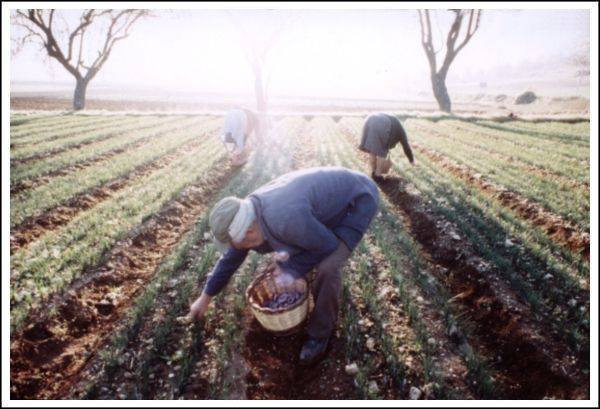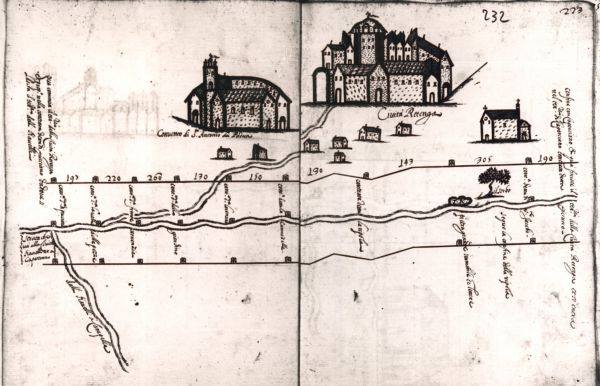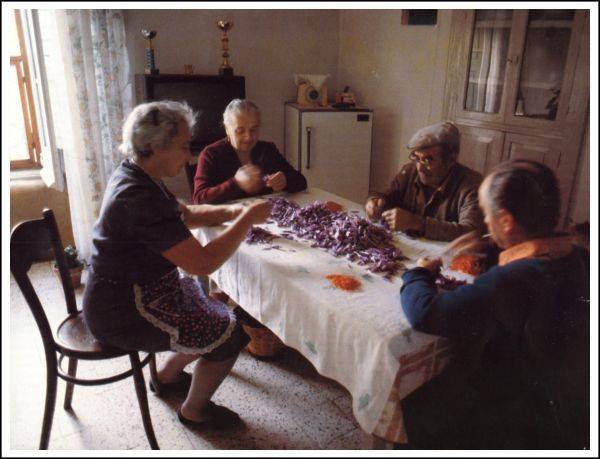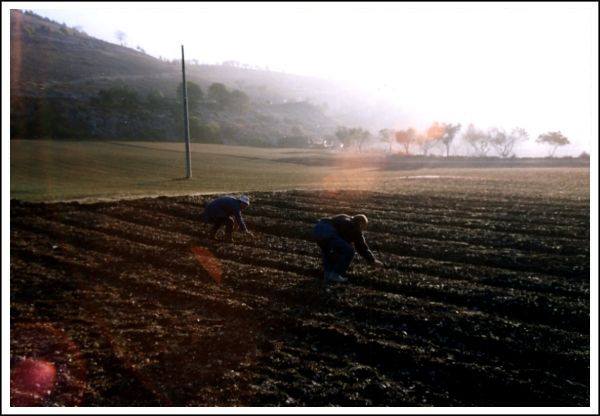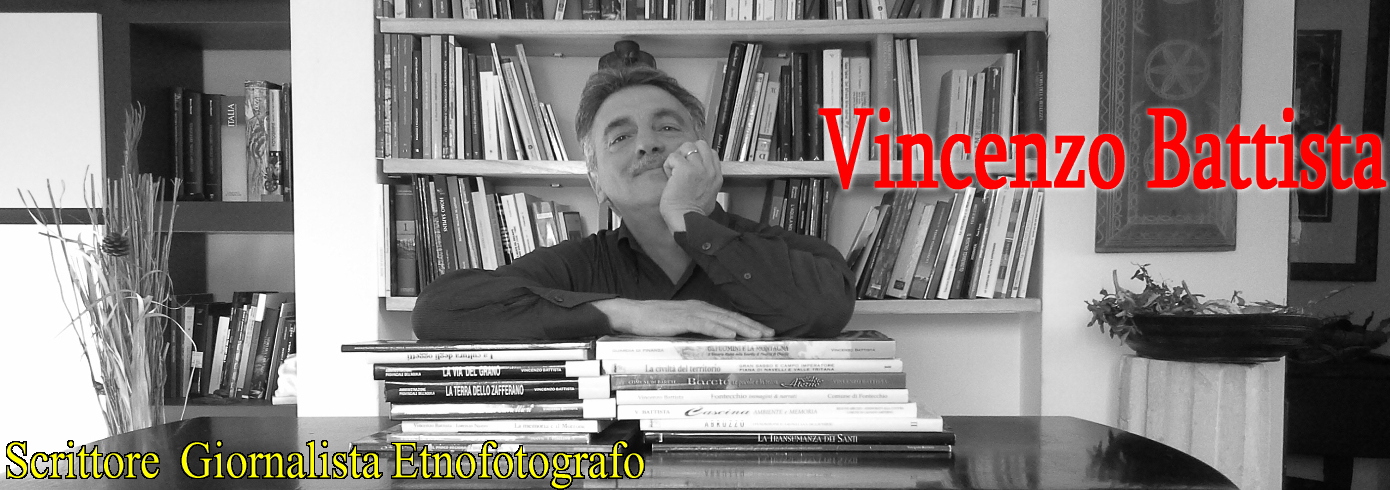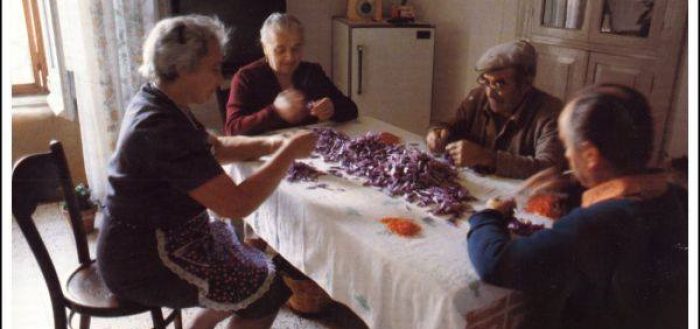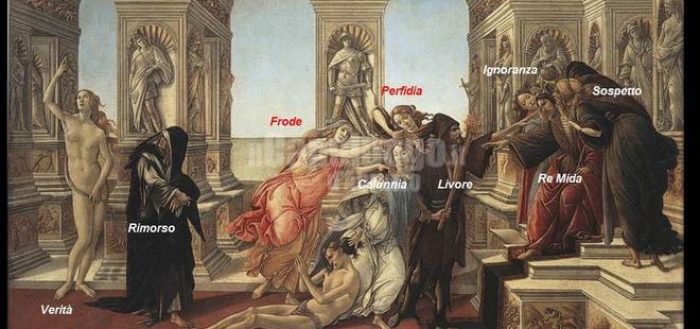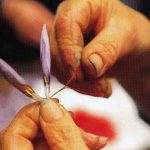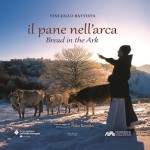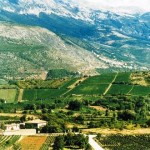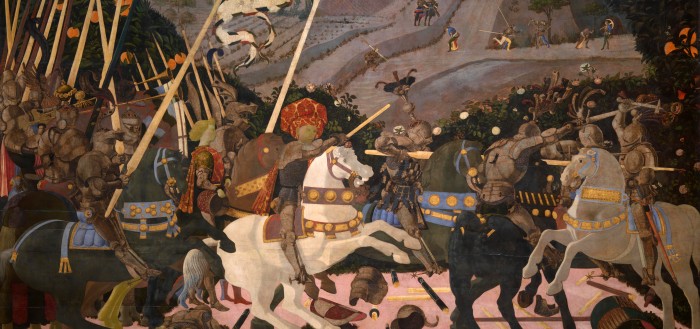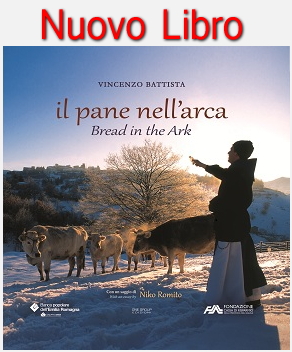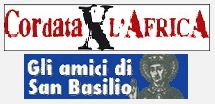ADESSO IL PAESAGGIO DELLO ZAFFERANO. Le campagne dell’aquilano: il contado, la preziosa spezia, il rito della raccolta.
Testo e fotografia di Vincenzo Battista.
Traduzione in inglese : prof.ssa Pierangela Badia
Lo zafferano, introdotto nella Piana di Navelli (AQ), trovò in quest’area particolari condizioni climatiche e predisposizione al suolo, tanto che la sua coltivazione occupò una vasta estensione di territorio, e rappresentò, insieme alla lana e alla seta, un settore economico di sviluppo storico e di benessere non solo per la città dell’Aquila, ma anche per l’intera provincia.
Tutte le famiglie dell’Altopiano di Navelli riservavano alla coltivazione dello zafferano una parte dei terreni insieme al grano e ai legumi. Lo zafferano era l’unico prodotto agricolo che permetteva, dopo la raccolta, di avere una disponibilità di denaro per la famiglia contadina a differenza degli altri prodotti del calendario annuale rurale che venivano comunque barattati.
Attraverso la “lettura” dello zafferano, la ricostruzione delle più importanti tecniche di coltivazione, il commercio, passa l’osservazione dell’universo contadino (di questa nicchia geografica dell’Abruzzo interno), originale ed emblematico, e l’analisi della famiglia rurale lacerata spesso dalla sussistenza, dall’emigrazione stagionale, da una economia locale povera di risorse che per secoli ha segnato i destini delle comunità locali di questo lembo territoriale dell’Abruzzo appenninico.
Le fotografie, i testi e i disegni , “documenti” di una lunga campagna di rilevazione sul campo (costituiti da migliaia di immagini, testi, ricerca storica ed archivistica, ecc.) nell’area dell’Altopiano di Navelli, illustrano solo un aspetto della grande cultura ambientale e storica dello zafferano nel contado e nelle “Terre dell’Aquila”.
SAFFRON LANDSCAPES
After being introduced into the Navelli plateau (AQ), the saffron plant found in the area specially favourable environmental and terrain conditions, and the spice cultivation occupied a vast extension of territory becoming, with wool and silk, an economic sector of historical development and welfare not only for the city of Aquila, but for the whole province as well.
All the families living on the Navelli plateau reserved part of the fields to saffron cultivation, alongside with wheat and beans. Saffron was the only agricultural produce that after harvesting allowed a farmer’s family to have a source of income in money, differently from the other products of the peasant’s yearly calendar that would usually be bartered.
Through a careful study of the history of the local saffron economy and the reconstruction of the prevalent cultivation techniques and trade, you can reach an awareness of the original, symbolic peasant’s universe (of this geographical niche in inner Abruzzo), of the rural family and its struggle for survival between the anxiety of seasonal migration and a poor local economy, all factors that for centuries have marked the destinies of the local communities on this side of Abruzzo Apennines.
The photos, texts and drawings of long research and survey on the field, through which I was able to collect by thousands of images, texts, historical and archival documents, in the area of the Navelli plateau, and they offer some insight into the great environmental and historical saffron culture in the jurisdiction and the “Aquilan lands”.
Le didascalie descrivono le fotografie, le mappe, i disegni nella galleria.
Foto aerea : il centro storico di Navelli.
L’altopiano di Navelli, lungo 22 km, largo 3 km ad una quota tra i 600 e i 700 metri, a circa 30 km a Sud – Est di L’Aquila, si estende nel territorio della Comunità Montana Campo Imperatore – Piana di Navelli, che comprende 17 comuni e diverse zone, omogenee dal punto di vista ambientale e architettonico.
Aerial photo: the old town center of Navelli.
The plateau of Navelli, 22 km long, 3 km wide, lies at an altitude between 600 and 700 meters, about 30 km southeast of L’Aquila, within the boundaries of the Comunità Montana Campo Imperatore – Piana di Navelli, comprising 17 communes and a number of other areas, homogeneous under the environmental and architectural point of view.
———————-
Il lungo corridoio carsificato dell’Altopiano di Navelli, è attraversato dalla statale 17 dell’Appennino – Abruzzese e Appulo – Sannitica che taglia centralmente tutto il territorio per circa 22 km. La Statale è un asse viario che divide il fondovalle coltivato a foraggio, grano, granturco, legumi e zafferano.
The long Carsic corridor of the Navelli plateau is crossed throughout its center for about 22 km by State Street 17 of the Abruzzo and Appulo-Samnite Apennine. The “Statale” is a road artery dividing the valley cultivated with forage, wheat, corn, beans and saffron.
————————
Le caratteristiche geologiche climatiche sono risultate determinanti per gli insediamenti medioevali che caratterizzano il paesaggio e costituiscono l’aspetto più importante per leggere i caratteri antropici delle comunità locali, le usanze e i riti, l’economia agricola, i culti religiosi che ancora da secoli si conservano.
The climatic and geologic features were of paramount importance for the medieval settlements typical of this landscape, and are the main interpreters of the local communities, their customs and rites, the agricultural economy, the religious cults that have been preserved for centuries and finally reached our times.
———————–
L’Atlante Capecelatro (1648 – 1652) contiene la documentazione iconografica e descrittiva relativa al tratturo L’Aquila – Foggia per il passaggio delle greggi di pecore in transumanza. La documentazione fornisce un interessante quadro delle caratteristiche del territorio e dei borghi dell’intera zona dell’Altopiano di Navelli coltivata con la pianta dello zafferano.
The Capecelatro Atlas (1648-1652) contains the iconographic and descriptive documents of the L’Aquila-Foggia Tratturo (shepherds’ path) used for the passage of the sheep flocks in their transhumance (seasonal migration). The documents supply an interesting picture of the features of the territory and the boroughs of the whole Navelli plateau where the saffron plant was cultivated.
———————–
Nella fotografia d’epoca, anno 1930 circa, si nota il centro di S. Pio delle Camere sullo sfondo e, in primo piano, i contadini che raccolgono lo zafferano.
This old picture (about 1930), shows the town of San Pio delle Camere on the background and, on the foreground, the farmers harvesting saffron.
—————————-
La raccolta del fiore di zafferano si effettua all’alba prima che sorga il sole. I fiori ancora chiusi sono colti manualmente e posti in ceste per essere trasportati in casa dove avviene la “sfioratura”.
The harvest of the saffron flower is made at dawn before sunrise. The flowers, still closed, are picked up by hand, placed into baskets, then carried to the homes where the “petal cropping” takes place.
————————–
E’ un lavoro che si ripete ogni mattina (metà ottobre, metà novembre circa) per l’intero periodo della fioritura dello zafferano. I fiori devono esser colti la stessa mattina della fioritura, per questo la raccolta necessita di numerosa manodopera. Il lavoro è compiuto in particolare da anziani e donne.
This work is repeated every morning (late October, mid-November) throughout saffron flowering. The flowers have to be picked up on the same morning when they blossom, which requires many people. Today the work is performed by the elderly people and women.
————————
All’interno del fiore di zafferano a forma di campanula ci sono tre stimmi. Gli stimmi, essiccati al fuoco del camino con un setaccio, danno lo zafferano usato in commercio, chiamato “in fili”.
Inside the bell-shaped saffron flower there are three stigmas. The stigmas, dried before the fireplace with a sieve, are used to make the saffron sold “in filaments”.
———————–
Il fiore viene raccolto prima che si apra con la luce del giorno, ancora chiuso si lavora poi in minor tempo. Quando la corona del fiore si apre sui campi, gli stimmi di zafferano si deteriorano.
The flower is picked before it opens to daylight, since when it is still closed it is easier to work on. If the flower crown should open on the fields, saffron stigmas would be ruined.
————————
Il documento più antico relativo al commercio dello zafferano è un diploma di Re Roberto del 28 marzo 1317. Con tale diploma si ordina ai secreti d’Abruzzo e ai loro ministri che i mercati aquilani di zafferano non siano gravati da un pedaggio straordinario…
The most ancient document connected to saffron trade is a diploma by king Robert dated March 28, 1317. With this document he ordered his governors in Abruzzo and their ministers that the saffron Aquilan markets were not to be burdened with an extraordinary tax …
———————-
Il fiore dello zafferano e gli stimmi. I primi statuti sul commercio dello zafferano furono banditi nel 1569 e si componevano di 12 capitoli. Il dilagare della frode nel commercio dello zafferano però recava danno specialmente ai commercianti della Germania, maggiori consumatori. Per questa ragione furono introdotte nuove disposizioni che salvaguardavano lo zafferano dell’Aquila, la produzione, le metodologie di conservazione e infine il commercio.
Saffron: the flower and the stigmas. The first statutes on saffron trade was posted in 1569 and consisted of 12 chapters. However, adulteration in saffron trade damaged dealers, especially Germans, the biggest consumers. Consequently, new regulations were introduced to safeguard the saffron of Aquila, its production, storing methods and trade.
———————–
I fiori raccolti vengono con i cesti trasportati in casa, conservati ad asciugare su una stuoia al buio prima di essere sfiorati. Fino agli anni ’50 i fiori venivano trasportati sui carri o a dorso di mulo nei cesti o in grandi lenzuoli in tela. Nelle immagini, la separazione degli stimmi ( zafferano) dagli stami e dal fiore campanulato.
Once picked, the flowers are carried in baskets to the homes, left to dry on a mat in the dark before being “deflowered”. Till the 1950’s the flowers were transported on wagons or on mules, in baskets or inside large cloth sheets. In the images, the separation of the stigmas (containing saffron) from the stamina and from the bell-shaped flower.
———————-
La “sfioratura”, con un contratto di lavoro verbale, chiamato “alla quindicina” era svolto dalle donne. Provenivano a piedi anche dai centri del Gran Sasso d’Italia. Lavoravano quindici giorni e ricevevano infine un cesto di derrate alimentari come “regalia” per la famiglia.
The “deflowering”, a job based on a contract by word of mouth, called “fortnight period” was performed by women. They came on foot even from the centers of the Gran Sasso Mountain. They worked fifteen days and they received finally a basket of food commodities as “gifts” for the family.
——————–
Il fiore dello zafferano, a forma di campanula, si compone di sei petali, rosso violacei riuniti in un tubulo alla base, da tre stami con antere gialle e da tre stimmi filamentosi color rosso scarlatto suddivisi in tre rami: lo zafferano.
The saffron flower, in the shape of a small bell, is composed of six reddish-purple petals, joined at the base in a small tube, by three stamina with yellow anthers and by three scarlet red filamentous stigmas divided into three branches, containing the saffron.
I disegni realizzati dal prof. Francesco Sfarra.
